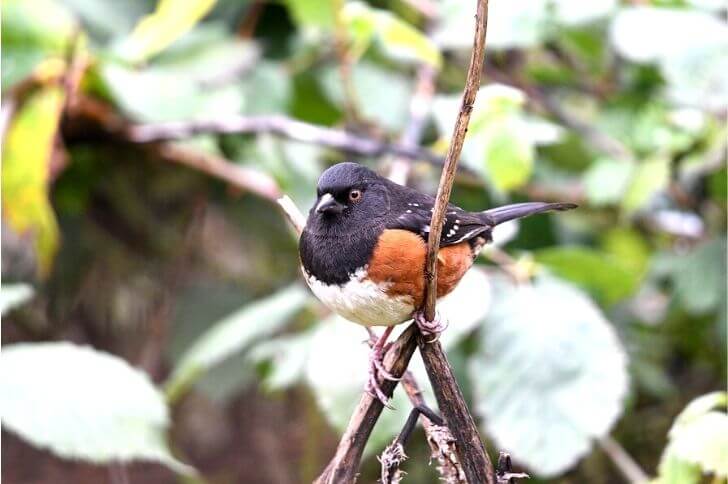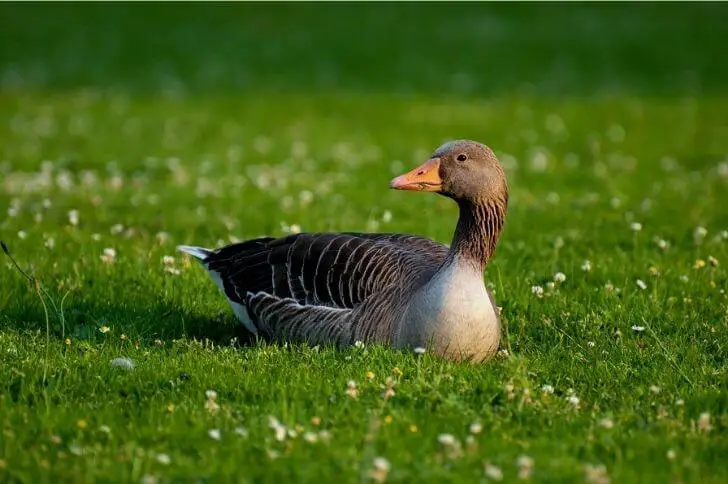The Southeast is home to some of the most diverse bird populations in the United States. This region contains a wide array of habitats including coastal, inland, and desert regions.
The birds of the Southeast have adapted to these different environments and can be found in every corner of the region. Whether you are a new birder or a seasoned birder looking to add more names to your journal, you’ll love the list below.
List of Southeast Birds
1. Blue Jay

Blue Jay – Cyanocitta cristata
The blue jay is a common bird in the Southeast. Its unique plumage makes it a great addition to any yard throughout the year.
Identification:
It is easily recognized by its blue feathers and white chest. Upperparts are blue with white and black bars on its wings. Notice the crest and the triangular wings.
Underparts are all white with a distinctive black necklace. Males and females look alike and measure 9.8-11.3 inches in length. Their body mass is about 3 oz.
Interesting facts:
The blue jay is a member of the crow family. It is a noisy bird that often mimics the calls of other birds. Blue jays are found in woods and forests. They eat acorns, nuts, and seeds. If you are interested in watching its life cycle, we recommend you install some nest boxes in your yard.
Southern birds can raise two clutches each year. Breeding happens starting March through July with parents raising about 5 blue jay juveniles.
2. House Sparrow

House Sparrow – Passer domesticus
Most people don’t like house sparrows and here is why. These North American birds are considered invasive; displacing native birds and taking up most of the resources.
Identification:
They are easy to identify. A small bird, it has a brown streaked back, light gray breast and underparts. The breeding male has black throat and gray crown.
In comparison, females are duller. Also, both sexes boast of short bibs that come in handy when foraging for food.
Other facts:
The house sparrow is found in urban and rural areas and is a common sight in gardens, parks and other open spaces. It feeds on a variety of seeds, insects and other small invertebrates.
Why is it hard to get rid of these invasive species? House sparrows are aggressive breeders. Unlike other wild birds, these small birds can raise up to 4 broods each year.
3. Mourning Dove

Mourning Dove – Zenaida macroura
The Mourning Dove is a beautiful bird in the Southeast. They feed on berries and weeds, making them an important part of the ecosystem.
Identification:
The adult Mourning Dove has a pale gray body with darker wings and a long, pointed tail. Wings are also rounded with black spots. The bird gets its name from its call, which sounds like it is mourning. Their slender body measures about 9-13.4 inches long.
Interesting facts:
Mourning Doves are gentle birds that are very shy around humans. Apart from weed, they’ll also eat peanuts. Check some peanut feeder stations for attracting these birds to your yard.
Also, the birds build their nests out of twigs and leaves near the ground in trees or bushes. The female lays two white eggs in the nest and incubates them for about two weeks.
Both parents take care of the young birds until they are old enough to fly on their own, which is about 2 weeks after they hatch. Mourning Doves are not endangered.
4. Northern Cardinal
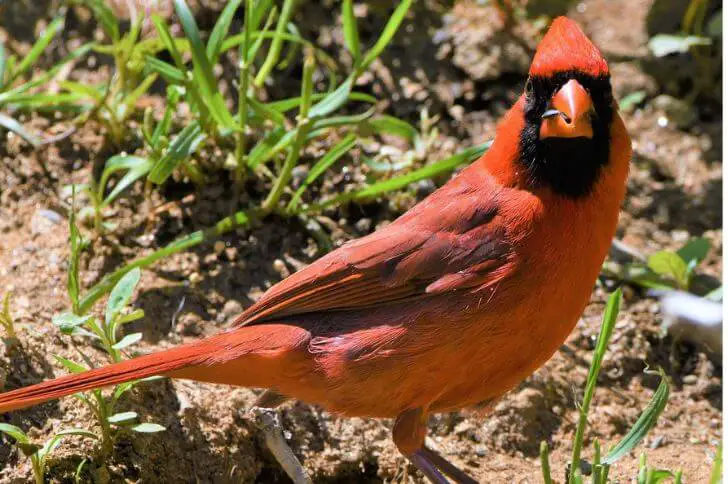
Northern Cardinal – Cardinalis cardinalis
Seen a red bird in your yard? The northern cardinal is a beautiful red bird of the southeast that prefers shrubby areas.
Identification:
These birds are relatively small, but they are very brightly colored and have a distinctive call. Males are all red with a black face while females are light brown overall. Both sexes feature red bills, a flame-colored crest and long tail feathers.
Interesting facts:
Cardinals are not afraid of humans, and they will often sit close to people in order to get food.
These birds are most active during the day, and they typically eat insects and seeds. Cardinals also play an important role in the Southeastern United States ecosystem by dispersing seeds and controlling insect populations.
These birds are a joy to watch for any bird watcher. During their nesting season you’ll notice the female constructing the nest where she’ll later lay 2-5 buffy white eggs. She’ll then sit on them for two weeks.
5. European Starling
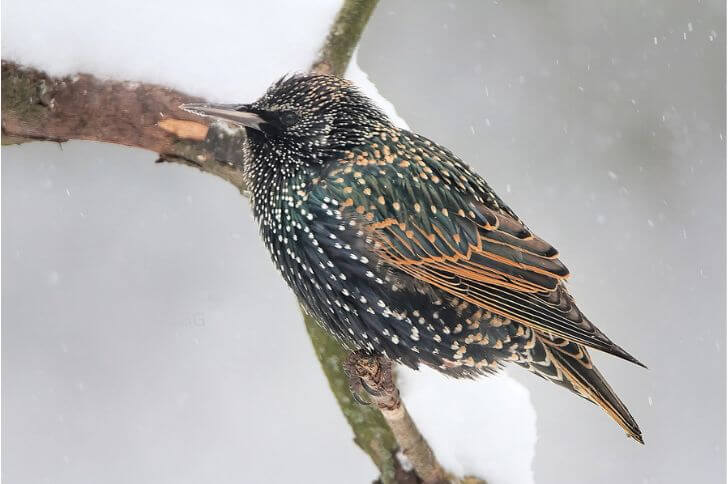
European Starling – Sturnus vulgaris
One of the most beautiful birds of the southeast is the European starling. Introduced in the United States in the 1860s, these medium-sized birds have grown in populations and can be found in most states all year round.
Identification:
European starling , also called common starling, is a small to medium-sized passerine bird in the family Sturnidae. The adult has black plumage with metallic luster, yellow bill and reddish feet. It is about 8 inches long and weighs 3 oz. Juveniles have browner plumage and a paler bill.
Other facts:
The song is a simple repetitive burr or twitter, often given in mimicry of other birds’ songs. Common starlings are commonly found on agricultural fields, backyards, and streets. They’ll also eat anything their beaks can find; from beetles to spiders to blackberries, these birds are not choosy.
6. Red-bellied Woodpecker

Red-bellied Woodpecker – Melanerpes carolinus
Saw a black and white bird tapping while bird watching? It could have been a red-bellied woodpecker and if you have some photographs, here is what to look for.
Identification:
Mostly found in eastern states, the red-bellied woodpecker is a medium-sized woodpecker about 9 inches in length . The adult is black and white. Males have a red nape and crown, while the adult female spots are red nape only. Both sexes have a black bill.
Other facts:
The red-bellied woodpecker is most often seen in deciduous forests, but can also be found in urban parks and gardens. These Southeast birds are a favorite among birds watchers because of their unique drumming, which is often used to communicate with other woodpeckers.
Like other members of their family, these avian species breeds between April and May raising 1-3 broods per year.
7. American Robin

American Robin – Turdus migratorius
American robins are state birds of Michigan but they can be found in Southeastern states namely Alabama, Georgia, Mississippi, and Louisiana.
Identification:
The American robin is a plump bird with gray-brown upperparts and rusty underparts. It has a black head with white eye-rings and a yellow bill. The female American robin is similar in appearance to the male, but her breast may be paler. Juvenile robins are browner overall.
Other facts:
Can you attract American robins to your yard? Absolutely yes. And, we recommend you get a large enough nest box that can accommodate a breeding pair.
Females do all the heavy lifting during the nesting season. You’ll notice them sewing the nest from the inside to the outside. They raise up to 3 broods per year.
8. Red-winged Blackbird
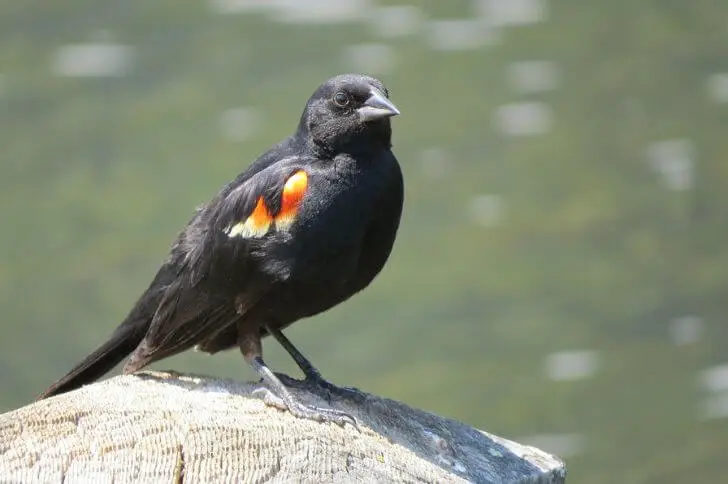
Red-winged Blackbird – Agelaius phoeniceus
The red-winged blackbird is a species of true blackbird that is widely distributed across the Southeast United States.
Identification:
Found all-year round in this region, they are easily distinguishable. The adult male has distinctive red and yellow shoulder patches and a black body with glossy feathers. The adult female is mostly brown with bold streaks. Both sexes have canonical bills and are about 6.7-9.1 inches.
Other facts:
Red-winged blackbirds are found in open habitats near water, such as marshes, wet meadows, and floodplains. They forage for insects and other small invertebrates in the vegetation or on the ground. Nests are built in trees or shrubs, often close to the ground. Red-winged blackbirds are monogamous and typically mate for life.
9. Carolina Wren

Carolina Wren – Thryothorus ludovicianus
The Carolina wren is a small songbird of the wren family. It is the only member of the genus Thryothorus. Carolina wrens are found in the eastern United States from Arkansas to Florida, and central Texas to southeastern South Carolina. The birds are common in woodlands, gardens, and parks.
Identification:
Carolina wrens measure 4.7–5.5 inches in length and weigh 0.71–0.81 oz. They have brown upperparts with heavy streaks on their back and wings. Their tail is long and brown with white bars. The underparts are light brown. Note the white eyebrows.
Other facts:
This small bird is known to explore gardens within its range. They favor insects and insects. They’ll also take snakes, frogs and fruit pulp. Like the American Robins they can raise up to 3 clutches each year.
10. Brown Thrasher

Brown Thrasher – Toxostoma rufum
A member of the family mimidae, the brown thrasher is a common backyard bird that is commonly found in parts of Southeast America all year round. It breeds in Texas.
Identification:
The brown thrasher is a medium-sized songbird with reddish-brown plumage and a long tail. Underparts are whitish with black streaks. These birds are about 9-11.8 inches in length and with a span of about 12.6 inches long.
Other facts:
It is found in open woodlands and hedgerows. The brown thrasher is the state bird of Georgia. It is a member of the genus Toxostoma, which includes about 100 species of thrashers, including the rufous-collared sparrow of South America and the Cozumel thrasher of Mexico.
The brown thrasher was first described scientifically in 1760 by Carolus Linnaeus, the Swedish naturalist who developed the modern system of biological classification.
It helps to control insect populations, making it an important wildlife species in the Southeastern United States. It also plays a role in dispersing seeds through its droppings.
11. Eastern Phoebe

Eastern Phoebe – Sayornis phoebe
Eastern phoebes are songbirds that are found during their non-breeding season in the southern states.
Identification:
Easily recognized by its distinctive call, this bird is often seen perching on branches or fence posts, waiting to swoop down on passing insects.
This dark-colored bird has a distinctive white breast and slightly forked tail. The male and female birds are similar in appearance, although the female may have slightly duller plumage.
Other facts:
Although it is not considered to be a threatened species, the eastern phoebe has undergone a significant decline in population in recent years. You can find them in wooded areas, mostly near ponds and rivers. Their prey includes beetles, cicadas, and ticks.
12. Fish Crow

Fish Crow – Corvus ossifragus
One of the most common birds of southern United States is the fish crow. A corvidae member, fish crows prefer wetter areas.
Identification:
Fish crows are black. They are about the same size as an American crow, but have a thinner bill. The bird is about 14.2-15.8 inches in length with a body mass of 6.9-11.0 oz.
Other facts:
Fish crows get their name from their diet, which consists mostly of fish. They will also eat crustaceans, mollusks, and insects. Fish crows are known to steal food from other birds, such as gulls and terns.
They are social birds that live in large groups. They make a loud “caw” sound that can be heard for long distances.
13. Black Vulture
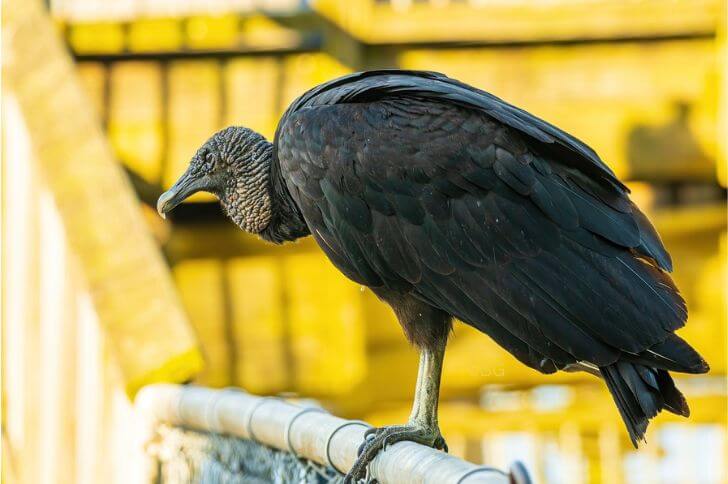
Black Vulture – Coragyps atratus
What are the birds of prey of Southeast? Black vultures are powerful birds that range from Texas to South Carolina to Florida.
Identification:
The black vulture is a large bird with a wingspan of up to six feet. This large bird of Southeast has black feathers and a bare head. The vulture’s tail is short and its beak is curved. It can live for up to 20 years in the wild.
Other facts:
The black vulture is a bird of prey that can be found throughout the Americas. It is a scavenger and feeds on carrion.It has also been known to kill small animals for food. The black vulture is an important part of the ecosystem because it helps to keep the environment clean by eating carcasses.
14. Brown Pelican
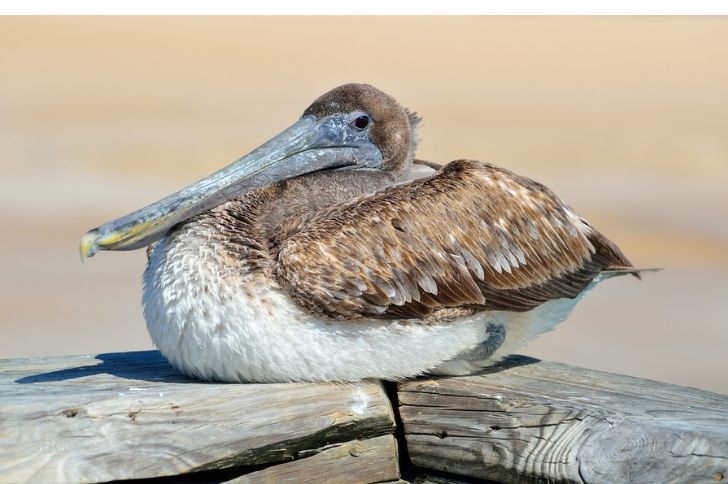
Brown Pelican – Pelecanus occidentalis
Large and majestic, The brown pelican is a large bird that can be found near the coastlines of Southeast US.
Identification:
These birds are unique in that they have a pouch on their lower bill that they use to catch fish. Brown pelicans are interesting creatures and are worth learning more about.
They can have a wingspan of up to six feet and weigh up to eight pounds. These birds are mostly brown-gray with some white on their neck, belly and breast. They are two-colored and long.
Other facts:
Brown pelicans typically eat small fish, but they will also eat crustaceans, reptiles, and amphibians. They will dive from high up in the air into the water to catch their prey. Their incubation periods are long, about 35 days with fledglings leaving the nest after three months. These shorebirds of the Southeast are interesting to watch.
15. Barn Swallow
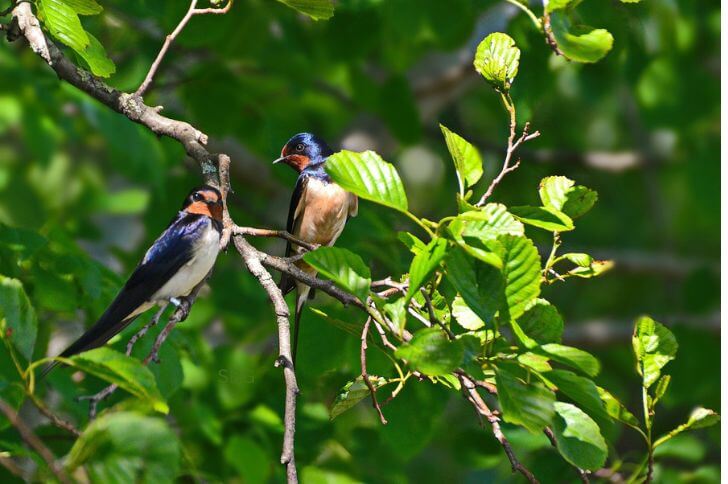
Barn Swallow – Hirundo rustica
When can you see barn swallows in the Southeast? From March to September, these small birds can be seen in pairs constructing a nest, taking care of the eggs and later raising their fledglings.
Identification:
The barn swallow is a small bird with a long, forked tail. It is a member of the swallow family. These swallows are about 5 to 7 inches long with a wingspan of 10 to 12 inches. The male has blue upperparts and a rusty-red throat and breast.
Other facts:
It nests in cavities, such as in barns or on cliffs. Barn swallows eat insects. They fly low over the ground or water to catch their prey. Like we said earlier, you can watch their early stages of life from March through September. During these months, barn swallows raise 1-2 clutches.
16. Roseate Spoonbill

Roseate Spoonbill – Platalea ajaja
Stunning and graceful, the roseate spoonbill is one of the most beautiful birds that is found in the southern United States. You can find them in South Carolina and Texas.
Identification:
These birds are a soft pink overall and their shoulders have a gorgeous darker shade of pink. Note the greenish head and yellowish patches close to their shoulders. Their bills are long and have a spoon-like shape that gives them their name.
Roseate spoonbills are wading birds and have long red legs that aid them in looking for food. Juveniles have soft pink feathers and grayish feet.
Other facts:
These birds are often seen wading in shallow water, looking for food. They use their bill to scoop up small fish, crustaceans, and other aquatic creatures. Spoonbills help to keep aquatic insects, prawns and shrimps populations in check.
The roseate spoonbill is a protected species, and there are only a few thousand of them left in the wild. So if you’re ever lucky enough to see one of these birds, be sure to take a moment to appreciate its beauty.
17. Pine Warbler
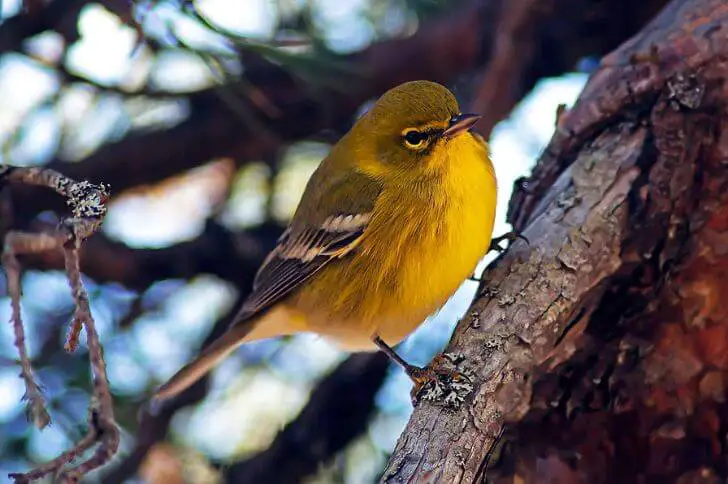
Pine Warbler – Setophaga pinus
One of the most common birds in the pine forest of the Southeast is the beautiful pine warbler. Known for its melodious tones, these little birds have similar plumage but can be different physically depending on the region.
Identification:
Pine warblers are small songbirds with yellowish-olive plumage, grayish wings, and whitish lower belly. Note the short bib and beady eyes. Females are duller. A mature pine warbler measures anywhere from 4.5 to 5.5 inches, the same size as a black-capped chickadee.
Other facts:
Pine warblers are year-round residents in many parts of their range, but some northern populations migrate south for the winter.
These birds eat mostly insects, although they will also eat berries and other fruit. They forage for food by moving through the branches of trees and shrubs, picking insects off of leaves and twigs. Pine warblers often hang upside down while foraging!
18. Cooper’s Hawk

Cooper’s Hawk – Accipiter cooperii
The Cooper’s hawk is a medium-sized hawk that is native to North America. It is a member of the Accipitridae family, which includes other raptors such as eagles and kites. The Cooper’s hawk is sexually dimorphic, meaning there are distinctive differences between the male and female of the species.
In terms of length and weight, the female is typically larger than the male. Both sexes have dark brown plumage with a barred pattern on their breast and belly. Their tail is rounded with a banded pattern.
Other facts:
The Cooper’s hawk was named in the early 1800s; after William Cooper. The scientific name for the Cooper’s hawk is Accipiter cooperii.
Like other large birds of prey of the Southeast, these birds help keep bird populations in check. They prey on European starlings and American robins. They’ll also eat chicken, squirrels and chipmunks.
19. Painted Bunting
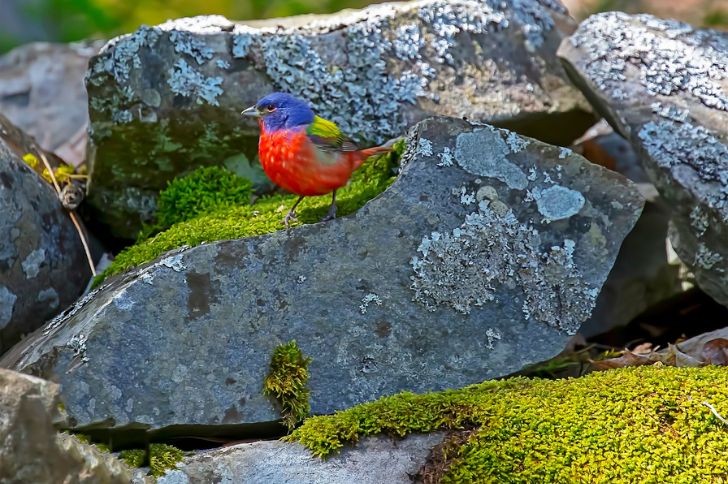
Painted Bunting – Passerina ciris
With their vivid colors and sweet notes, painted buntings are some of the most interesting birds one can have in their home. Their vibrant colors make identification easy.
Identification:
These birds are known for their bright plumage, which is made up of shades of blue, green, and red. In contrast females and fledglings are yellow-green. Both sexes have short seed-eating bills. The birds are about 4.8-5.5 inches in length.
Other facts:
The painted bunting is a popular bird among birdwatchers, as they are relatively easy to spot and photograph.
During nesting season, they build nests about 6 feet off the ground. It then takes them two days to build a soft, yet solid nest. They raise 1-3 broods each year depending on the availability of food.
20. Burrowing Owl

Burrowing Owl – Athene cunicularia
Burrowing owls are very distinctive birds. From their calls to the plumage to their unique eyes, they are unmistakable. Here are other interesting things about these owls of the southeast.
Identification:
Burrowing owls are small, long-legged owls with large heads and dark eyes. They are a mottled brown with a 7.5-9.8 inches long body.
Other facts:
They get their name from their habit of nesting in burrows that they either dig themselves or use those made by other animals such as ground squirrels. These owls are found in open grasslands throughout Southeast America.
Burrowing owl populations are in decline all across North America. Scientists believe that this is due to the loss of suitable habitat, as these owls require open, grassy areas with very few trees. This makes them especially vulnerable to the effects of urbanization and agriculture.
While they are adaptable birds, burrowing owls are very sensitive to changes in their habitat. The loss of even a small amount of suitable habitat can have a significant impact on local populations.
21. Reddish Egret
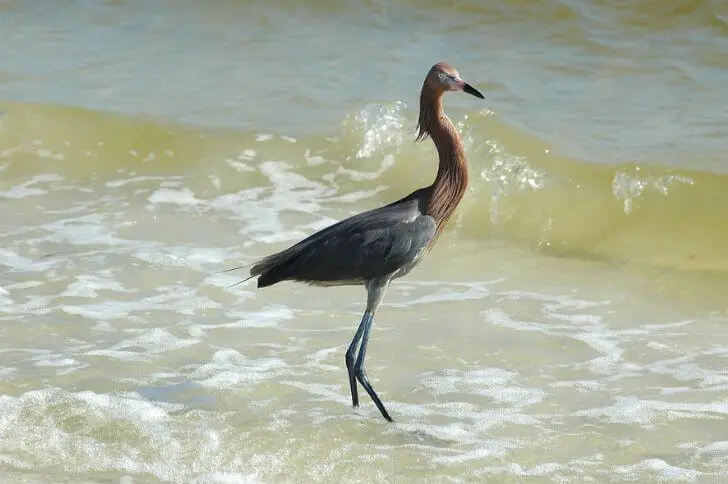
Reddish Egret–Egretta rufescens
In the enormous family of egrets, reddish egrets are the flamboyant sibling. Large and tall, this bird comes in two distinctive morphs.
Identification:
These water birds of southeast are a bit larger than most other egrets. Morph one is an all-white bird with a pink, black-tipped and long bill. Morph two is a dark gray plumage with a bluish face, and a black-tipped pink bill. They also have long, thin necks and legs.
Other facts:
Reddish egrets are found in coastal areas mostly in Florida. They typically eat small fish, but they will also consume crustaceans, amphibians, and reptiles. These birds breed in colonies near water, and they build their nests in trees or bushes.
If you’re lucky enough to see a reddish egret in the wild, you’re sure to be impressed by its beauty and gracefulness.
Final Thought on birds of the Southeast
In conclusion, the birds of Southeast are some of the most beautiful and varied in the world. With so many different species, there is something for everyone to enjoy. So get out there and start bird watching today!
Sources:
https://en.wikipedia.org/wiki/Category:Native_birds_of_the_Southeastern_United_States
Hi fellow bird watcher. Welcome to our small corner of the world. At the spanishbirdguides.com our mission is to share with other bird watchers the things we love about birds, where to go bird watching within the United States, and more. I’d also love to hear from you. Feel free to contact me about your bird watching escapades, share videos, photos and more.
